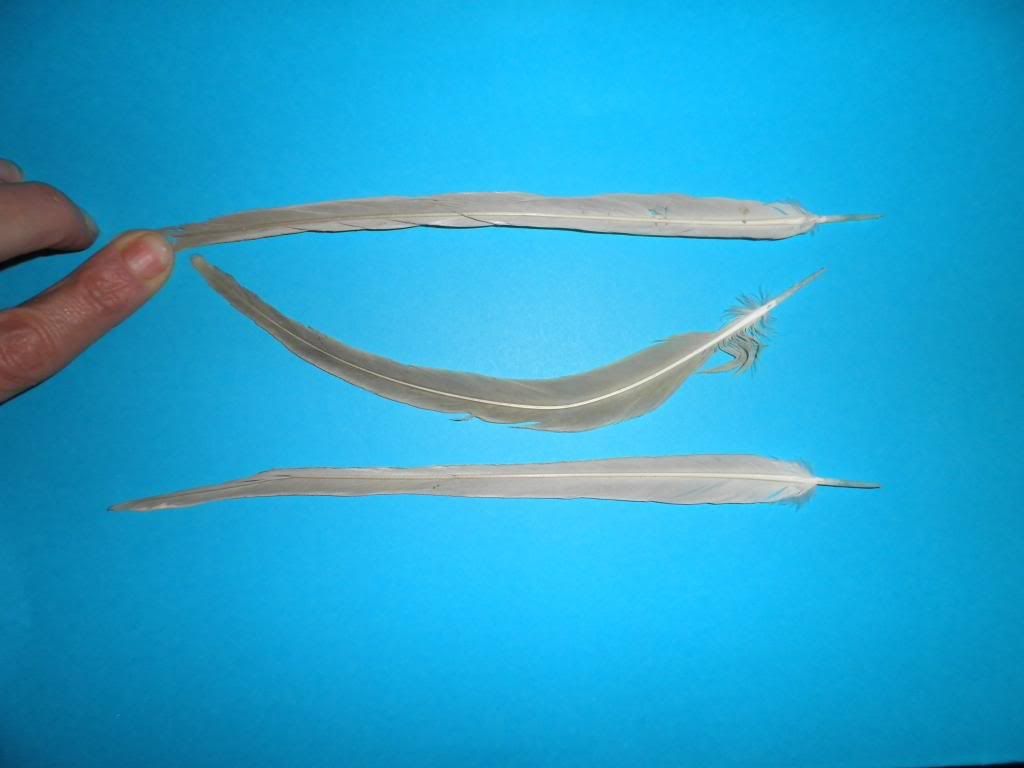I have received Mike's feathers from his "Emerald Turquoise Cleartail" and "Emerald split Cleartail" females, and I have look at them under a broad spectrum uv ligth and under a LED torch emitting at 395 nm. The observations are the same for both birds in both pulled and molted feathers.
Under 395 nm I can easily identify the patched fluorescent psittacin on undercovert feathers. This psittacin is not present in the whole feather but only on the most external part, similar to what has been described in green, lutinos and parblues birds. The rest of the feather appears non fluorescent. Tail feathers and primary flying feathers are not fluorescent.
Under a broad uv spectrum every feather appears fluorescent, on its totality, with a little difference in hue respective to the 395 nm torch, and, as Willy points, the underneath part of the tail feathers is more fluorescent than the above part. With my lamp I can not confirm Deon's observations of a bluish fluorescence but it looks more like a green-yellowish hue. I can not see at the same time both types of fluorescence because the yellowness present under the broad spectrum uv lamp masks the patches I can see under 395 nm.
Under normal ligthing I can make the difference between a normal Blue tail feather from my collection and the Emerald tail feather, looking at the underneath part, which shows a yellowish colour only in the Emerald feathers (this last point can easily be confirmed by Mike by having a close look at his birds). I can also see some feathers dysplaying a yellow colour only on the most exposed parts, and this area matches fluorescence under 395 nm.
Which is my interpretation? I think that all these feathers belong to green series Emerald birds because:
1. I can see the patched psittacin in independent feathers both under normal ligthing and under 395 nM.
2. I can make the difference between Blue and Emerald tail feathers under normal ligthing and under broad uv spectrum (not under 395 nm since there is not fluorescent patched psittacin in tail feathers)
2. Emerald is present in every feather as can be detected under uv broad spectrum.
So these observations are consistent with the idea that Mike's Emerald females are in fact green series birds, and that the mother of the 7 birds discussed previously is a Green Emerald Cleartail/Turquoise female.
It seems that it is not possible to make the difference between a central Blue tail feather and a central Emerald Blue tail feather under normal ligthing (Madas' reports on Willy's observations). If this is the case (not report of any difference on the underneath feather colour between Blue and Emerald Blue ... and I do not own either the birds or the feathers to verify), the easiest key to make the difference between a Blue and a Green series Emerald, under normal ligthing, could be the underneath colour of the central tail feathers : yellowish only in the green series.
The different hue in fluorescence under broad uv spectrum respective to Deon's observations could be due to a different ligth source but also to the presence of psittacins in those birds (whenever Deon's Emeralds were Blue series birds).
Under broad spectrum uv ligth the whole feather from Emeralds appears fluorescent and the underneath fluorescence is even higher. These are observations pointing to Emerald as a structural colour since the production of any pigment is not a costless bussiness for birds: if you look at the distribution of psittacin pigments in the feathers you will remark that they are deposited only in the parts exposed to the ligth. The inside parts or those kept under neighbouring feathers are without pigments. Far more, pigments are never deposited in a feather in an homogeneous way but in different concentrations depending the task to perform (sexual atraction, mechanical resistence, camouflage, ...).
Another conclusion related to the different fluorescence in Emeralds: we knew by Deon's reports (although the first report was a private communication from Willy) that the emitted fluorescence quality was different between the "normal" fluorescent psittacin present in Wild, Inos and Par-inos (or Parblues) and the Emerald fluorescence. Now we also know that the uv absorbed to produce fluorescence is also different: Emerald does not fluoresce when using uv ligth in the 395 nm range, so its absortion peak must be under 360 nm (the real peak emision of the 395 nm LED is around 370-450 nm, depending on intensity) while the patched psittacin fluoresce at around 395 nm. Very probably we could independently identify one and the other by using the 395 nm LED torch (specific for patched psittacin) and another one emitting in the 320-360 nm range (specific for Emerald fluorescence). Anyway both psittacins (whenever they are both psittacins) seem to show differents absortion and emission peaks.

Thanks a lot to Mike for providing the feathers. It would be great to get some feathers from people owing Blue series Emeralds for close uv fluorescence studies.
Regards
Recio









